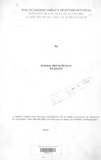| dc.description.abstract | Tourism is the phenomena arising out of the joumeys and temporary stays of
people travelling for leisure and/or recreation purposes, for business and those
attending conferences. Tourists on the other hand are visitors or travellers to an
area staying for at least twenty four hours or more for various purposes.
International tourism which is the main purpose for this study involves international
travel and contrasts with domestic tourism involving travel within a country by its
own residents.
The present study aims at assessing the economic impact of international
tourism on Lake Victoria Region of Kenya. This area covers Western and Nyanza
Provinces and certain districts in the Rift Valley Province namely Uasin Gishu,
Trans Nzoia, Nandi, Kericho and Narok districts. The area has not been in the front
line in terms of touristic activities. However, in the future, it is likely to become one
of the leading tourist circuit to compete for visitors with other traditional tourist areas
such as National Parks and Reserves and the coastal beaches, once the region is
given the required attention by both Government and private sector.
Tourism in general has been identified by both developed and developing
countries for playing a major role in national economies to the extent that the sector
has attracted both government and private funing and investment. Economic,
socio-cultural, physical and/or environmental impacts of tourism have been
identified. Whether these impacts are positive or negative depends on how the
industry is managed thereby calling for sound management policies to promote the
positive impacts while minimising the negative ones. For this reason, various
researches have been carried out in various parts of the world on issues related to
tourism. Most of the previous researches on tourism in Kenya have been at the
national level and within resort enclaves. An assessment of tourism on a regional
scale such as this one is important since it acts as a bridge between the microscale
studies and the large scale ones. Because of the positive and negative
impacts tourism may have in a region, this study is set to establish the extent to
which international tourism in particular has negatively or positively made impacts in
the region. The major objectives therefore are:
(a) To establish the touristic potentials of Lake Victoria Region;
(b) To assess the tourist infrastructure in the region;
(c) To analyse the structure of tourism in the region;
(d) To assess the contribution of international tourism in Lake Victoria
Region; and
(e) To assess the environmental cost(s) of the tourism industry in Lake
Victoria Region.
The hypotheses for the study are:
Ho: Most of the economic activities related to international tourism in the
region are not carried out by the local people
H1: Most of the economic activities related to international tourism in the
region are carried out by the local people . '.~~.
Ho: There is no significant relationship between tourism and economic
development in Lake Victoria Region
H1: There is a significant relationship between tourism and economic
development in Lake Victoria Region
Ho: Lake Victoria Region's tourism is not highly localised
H1: Lake Victoria Region's tourism is highly localised
In order to achieve the above objectives and to accept or reject either the
null or the altemative hypotheses, a nine-month field work session was undertaken
which involved travel to the various tourist sites, interviews with key players in
tourism such as hoteliers, formal and informal employees among others, and
interviews with govemment officials in the industry. Apart from direct field
observations the study made use of secondary data from various institutions.
The statistical techniques used in the study include simple tables, location
quotient, coefficient of localization and localisation curves. The location quotient
shows that tourism is much concentrated in Nairobi and Mombasa and not in the
Lake Victoria Region. The coefficient of localization shows that tourism activities are
not evenly distributed in the country. Some provinces and major towns have a
greater share of tourism activities as per the location quotient, coefficient of
localization values and the localization curve.
The results from the study provide vital information conceming tourism and
may act as a useful guide for the management of the industry in Lake Victoria
Region. Recommendations made are meant to promote this industry in the region.
They are aimed at opening the region for greater tourist activity and therefore
include developing the tourist sites and infra-stru.cture accompanied with aggressive
marketing. This is to go hand in hand with the education of the local people and
their empowerment so that they take up the opportunities in the industry within the
region. The study gives areas for further research such as the domestic tourism
sector in Lake Victoria Region. | en |

